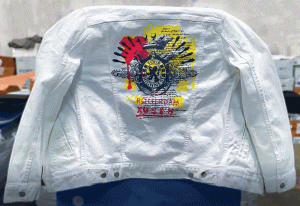A direct hit: How DTG printers are helping pros meet the moment

The market for direct-to–garment (DTG), has moved beyond T-shirts. There is now custom printing available on larger margin items like jackets. Photos courtesy Roland DGA
By Kitt Jones
In the past few years, one of the most important changes in the printing industry has been the increase in demand for direct-to–garment (DTG). A large part of this change is due to a growing trend in customization and personalization, accompanied by the rise of e-commerce and “one-stop shops” offering customers a wide range of apparel resources.
Despite the effects of the pandemic, DTG printing product sales reached US$202 Million (C$253 Million) in 2021. It is predicted that the global DTG printing industry will experience a compound annual growth rate of 8.3% over the next 10 year.1
Today’s print shop clients are often looking for specialty printed and short-run apparel along with their graphics, and DTG printers have emerged as a critical technology. Manufacturers are reacting with DTG printers that offer greater flexibility and appeal as an internal resource.
Managing demand
Customers are asking for more products in DTG such as bags, hats, T-shirts and hats. However, many print shops owners have been unable to supply these services internally. To satisfy their clients’ requests, print service providers (PSPs) have been outsourcing their DTG production—which can constrain the shop’s ability to control quality, timing, and costs.
Printer manufacturers have created innovative DTG printing technology to address this need. DTG printing workflows are now more flexible and accessible than ever thanks to these changes. Today’s DTG printers are both powerful and versatile, providing the on-demand production capability needed to help PSPs fulfil custom and short-run orders in-house.
The evolution of DTG technology
DTG printer owners have been able to find ways to speed up their production over the years using a variety heat pressing and pre-treatment techniques. Although this technology is getting more powerful and cheaper, one-platen printers can only produce so much.
Today’s improved inks and more comprehensive software are important for increasing the speed and efficiency of DTG printing. Flexibility in print production, however, is what really makes a difference. Flexible printing allows companies to diversify and differentiate themselves from their competition.
DTG printer technology allows for faster production with a wider range of materials and substrates. Roland DG has recently released a DTG Printer with a 1346.2 x 1625.6mm (53 x64-in.). The bed is 203.2mm (8 in.) and the printer has a 203.2mm (8 in. Z axis, which allows users to print multiple shirts at once or on larger products such as blankets, jeans, towels, and blankets. Print shop owners will see a rise in profitability due to the versatility and power of these printers.